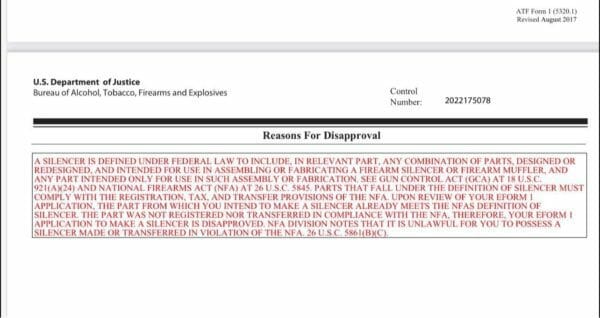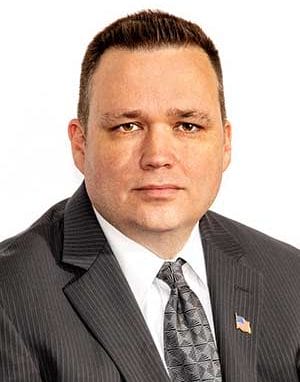UPDATE: The ATF held 3000 Form 1 Suppressor applications for further investigation. Out of those 3000, 850 were being built from “solvent trap” kits. Those 850 were denied. Furthermore the information was forwarded to the local field offices because those kits are unregistered suppressors in the eyes of the ATF. Owners might receive a visit!
TOPEKA, KANSAS –-(Ammoland.com)- AmmoLand News has received reports that many people waiting for the Bureau of Alcohol, Tobacco, Firearms, and Explosives (ATF) to approve their Form 1 tax stamp for their homebuilt suppressors received a rejection from the National Firearms Act (NFA) Division.
AmmoLand News has confirmed that the ATF rejected multiple people’s Form 1s en masse with the same language on the same day. Forms with the exact wording have been approved many times by the division.
The rejection notice says that any part ordered for the homebuilt suppressor would be considered a suppressor itself. Therefore, the builder would violate the NFA for the purchased components.
80% Silencers Banned?

One lawyer who reviewed the ATF’s rejection response commented off the record that it could make the iron ore itself a silencer if someone decides to make a suppressor using steel made from the iron.
If the rejections are legitimate and not a mistake by the ATF, it would be impossible to make a homemade suppressor.

The ATF just switched over to eForms. Some theorize that there is an error in the programming, generating false rejections. AmmoLand News reached out to the ATF to clarify if this was an error or not?
ATF replied:
“Pursuant to 18 U.S.C. 921(a)(24), 27 CFR 478.11, and 27 CFR 479.11, the terms “firearm silencer” and “firearm muffler” mean “any device for silencing, muffling, or diminishing the report of a portable firearm, including any combination of parts, designed or redesigned, and intended for use in assembling or fabricating a firearm silencer or firearm muffler, and any part intended only for use in such assembly or fabrication.” A device or part that falls under the federal definition of “firearm silencer” and “firearm muffler” are each considered a “firearm” subject to the provisions of the Gun Control Act (GCA) and the National Firearms Act (NFA).
In general, a Form 1 shall not be approved if the making or possession would place the person in violation of the law. It is unlawful for a person to make a silencer from a device or part that falls under the federal definition of silencer and was transferred to the applicant without complying with the tax, transfer, and registration requirements of the NFA.
An approved Form 1 authorizes the maker to make the silencer identified on the Form 1 application, and approval of the Form 1 application registers the silencer to the maker in the National Firearms Registration and Transfer Record (NFRTR). The maker must certify on the Form 1 application under penalties of perjury that the maker is the person who will make the silencer. An approved Form 1 does not authorize any person to make or manufacture the silencer on behalf of the Form 1 maker. An approved Form 1 does not authorize the transfer of a device or part that falls under the federal definition of silencer to the Form 1 maker. An approved Form 1 does not legitimize a prior transfer of a device or part that falls under the federal definition of silencer that did not comply with the tax, transfer, and registration requirements of the NFA.
We direct you to the June 2021 FFL Newsletter for more information about Silencer Markings and Registration Requirements which includes this reminder:
If someone other than an FFL/SOT wants to acquire a silencer part, that part must be marked in accordance with regulations and registered by filing a Form 2… A Form 4 must be filed if the part is being acquired by an unlicensed person or FFL who is not qualified under the NFA.”
The ATF has cracked down on buying and selling “solvent traps” and fuel filters that gun owners have converted to homebuilt suppressors. Some of these items have been purchased on Chinese sites such as Wish and Aliexpress. The ATF has tracked the sale of the items from overseas. Others components have been purchased from American-based companies. The ATF says they do not regulate solvent traps, but that doesn’t appear to be the case.
Diversified Machine was one American Company that sold solvent traps. The ATF put the company out of business and seized its website. The ATF claims markings on the caps and refrigerator plugs (used as baffles) could be used as drill guides. The ATF considers this to be readily convertible.
Some buyers have had their items confiscated by the ATF. Even one YouTuber who works on diesel trucks got a visit by special agents demanding he turn over the “silencers” he purchased online. In this case, the YouTuber used the filters for their intended purposes.
Some other advocates worry that these rejections are a sign of things to come from an increasing out-of-control agency. New regulations surrounding unfinished frames and receivers are expected to be unveiled by the ATF this summer. These regulations also include homebuilt suppressors. If the rule goes into effect as written, it would be a de facto ban on the items.
One person AmmoLand News spoke to wondered if this is the ATF showing their hand about the new regulations early. Without the ATF directly addressing the concerns of home builders, it is hard to know. More and more people are reporting the rejection notice. This turn of events is concerning and developing.
If you have had a Form 1 approved by the ATF for a suppressor since March 1, please drop us a line and let us know to investigate further.
About John Crump
John is a NRA instructor and a constitutional activist. John has written about firearms, interviewed people of all walks of life, and on the Constitution. John lives in Northern Virginia with his wife and sons and can be followed on Twitter at @crumpyss, or at www.crumpy.com.

